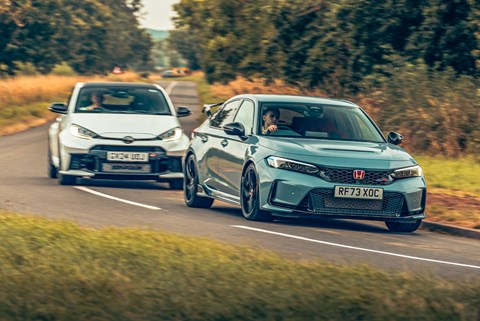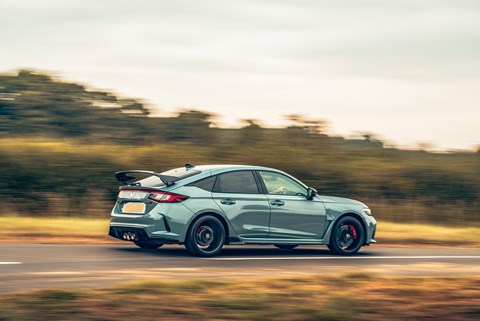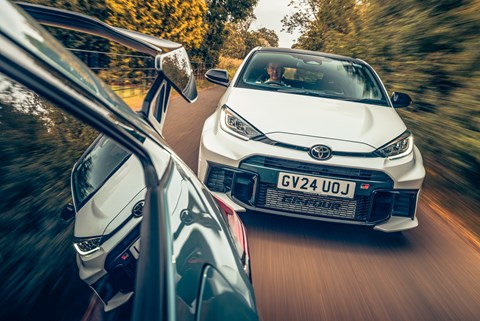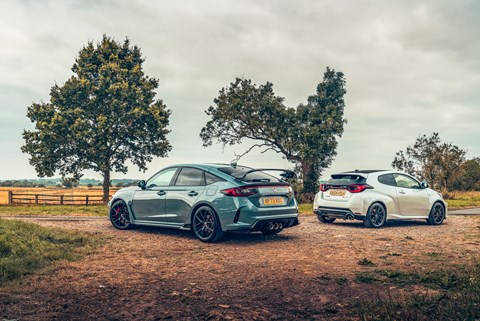► GR Yaris Gen2 vs Civic Type R
► Two hot hatch greats battle for supremacy
► Are the Yaris’ improvements enough to topple the Type R?
Toyota’s given its sensational GR Yaris lower seats, more power and a suspension tune. Honda’s evolved the Civic Type R into a £50k tour de force. Fight!
Pre-flight briefing: Toyota GR Yaris Gen2
Why is it here?
Because we’d long since given up on driving anything like a Mitsubishi Evo or Lancia Delta Integrale ever again. While those cars left no one in any doubt that rally cars make exceptional high-performance road cars, apparently they just weren’t what people wanted. Until Toyota, prodded by arch-enthusiast Akio Toyoda, built a modern rally car for the road. Cue rave reviews and a waiting list that stretched into next year. Like a funny-looking GT3 911, low-mileage examples changed hands for more than list price, so skewed were supply and demand.
Any clever stuff?
The rip-snorting turbo triple has been persuaded to produce even more power and torque, despite displacing just 1.6 litres. Give the little guy a break! There’s also stronger, re-tuned suspension, a stiffer bodyshell, a new eight-speed automatic transmission option, a re-designed cockpit (with lower seats, crucially) and a single, higher spec, complete with the old Circuit pack’s diffs and improved cooling. As before, GR-Four knob adjusts the front/rear power split.
Which version is this?
The only one, though there are two £60k special editions.
Read our GR Yaris review
Pre-flight briefing: Honda Civic Type R
Why is it here?
Because ever since Honda finally turbocharged the Civic Type R, elevating it from sweet-handling but under-gunned also-ran to deadly serious performance car, it’s always been right at the top of the hot-hatch leaderboard. The previous-generation FK8 divided with its looks but united almost everyone in their praise for its sensational speed, handling and inch-thick polish (its metaphorical polish, as opposed to its actual polish). Totally overhauled last year, the current car is bigger and heavier but far stiffer and better looking inside and out. The only bad news is the £50k price, but you’re used to wincing at every price you read by now I’m sure.
Any clever stuff?
Stiffer bodyshell uses a whole heap more adhesive, to reduce flex, and every key component in the suspension and steering systems is monstrously rigid. Adaptive dampers give the Honda a great deal more bandwidth than the Toyota, and can be combined with sportier settings for everything else.
Which version is this?
Standard spec includes all the important stuff, so your only options are the Cargo pack (£150) and, if you don’t like grey, any other colour (£650), though the accessories range is vast.
Read our Honda Civic Type R review
GR Yaris Gen2 vs Civic Type R: the test

The Hundred, cricket’s snack-peddling and highly snackable quick-fire format, is compelling TV. Test matches – like Le Mans – ebb and flow over days, the narrative coalescing only once you’ve deigned to invest the required hours of your life. The Hundred final was smashed out in a couple of hours of devastating bowling, flying stumps and big hitting. My eyes should have been glued to it.
But they were not.
Just outside the living-room window sat the Civic Type R. On what was a fine summer’s evening its low-profile rubber, mile-wide track widths and swollen arches spoke of barely comprehensible corner speeds. All weekend DPD drivers, postmen and neighbours had told me how good it looked and I’d agreed, telling them I’d only so far trundled it home; that a proper drive must wait until next week. Then a switch flicked, the cricket I wasn’t watching was forgotten and, with the flimsiest of excuses, I was out of the door.
If you rate the Honda’s exterior design, the interior does nothing to derail the surprise and delight. The cockpit is transformed versus the previous-gen FK8 Type R, though it fortunately clings to all that was right about that car’s driving position. You sit low in sensational sports seats; seats that rubbish the notion that buckets can be comfortable or they can be supportive but they cannot be both. Figure-hugging, deeply padded and beautifully finished, leaving them is like being torn from the womb – and just as upsetting. They’re low, too: low in the car and, because of the Civic’s zero-bullshit chassis set-up (naughty negative camber and the kind of ground-hugging ride height that rules out most rural laybys), low full-stop. The steering wheel, slightly bigger than I’d like but adjustable and beautifully finished, can be put exactly where you want it.
The good news keeps coming. The pedals are perfectly spaced and weighted. The gearlever and transmission are essentially perfect, such that the very first time you pull away and shift up through the ’box – the very first time – you do so flawlessly, like you and this Honda have already done years and a quarter of a million miles together. The mode selector is intuitive and, brilliantly, soon redundant, in that once you’ve made Individual right for you (most everything in Sport but with Comfort damping and steering) you can forget about modes – the car will be in Individual next time you start it up.
Sure, the trigger-happy collision and lane-departure warnings re-arm themselves with every re-start but they’re easily disabled via a scroll wheel on a steering-wheel spoke before you’ve even left the driveway. The touchscreen, while at least a generation behind BMW’s dual-screen, iMax-style madness, is perfectly serviceable, and benefits from physical buttons for the home and back functions.

Just what is it that I’m trying to say? Well, essentially that the Civic Type R is very obviously a car about which many very smart people have sweated, and upon which a level of care and attention to detail far beyond the norm has evidently been lavished. The last car I drove that felt this crafted, this polished, was the Porsche 911’s anniversary special, the S/T (and your first pull-away and upshift in that invariably comprised at least two stalls and a graunch).
All of which is a bit of a worry for the GR Yaris, buffed, tuned and fettled for 2024. The good news is that you now sit 25mm lower (the first-gen car’s driving position was more SUV than WRC); the bad news is that you do so in front of what is less a dashboard and more a wall of not very premium plastic. The Honda’s lovely dash, with its top-drawer materials, colourful and feature-laden infotainment screen and neo-retro band of horizontal dash mesh, almost like a ’70s Ferrari or Alfa, feels from a different world – and price point. The shift paddles for the GR’s new auto ’box option (we also drove the auto but fielded a manual Toyota against the very manual Honda) are similarly cheap feeling, even if their action is crisp enough.
Out on the road, the Civic does a passable impression of being a normal car. The ride, while a shade less comfy than the FK8 in its softest Comfort setting, is entirely tolerable on most roads, with only the lumpiest tarmac forcing you to either grimace or slow down. There are four doors, plenty of legroom in the back (this Civic’s 35mm longer between the axles than its predecessor) and tyre roar, while noticeable, is inconsequential next to the GR Yaris’s rolling racket. Fuel economy would appear to be 25mpg regardless.

But the Civic is not a normal car. Drop a gear, ease down the throttle and the Honda fires itself off up the road like a ballistic bar of soap between squeezed hands. The turbocharged four is an evolution of the unit that powered the previous car, tweaked here with a redesigned turbo for reduced inertia, increased cooling, reduced back pressure and changes to the ignition and valve timing to sharpen throttle response. Acceleration is strong from 3000rpm (peak torque chimes in at just 2200rpm – peaky it is not) and so compelling from 4500rpm you’re tempted to wonder if it’s worth hanging on for the last 1000rpm, right up to the 7000rpm redline. It is. Cutely, the final rush feels every bit as majestic as Honda’s pre-turbo Type R motors, the horizontal digital tacho calling to mind the slightly bananas S2000, even if that peaky and tricky little two-seater wouldn’t see which way this Civic went.
To slingshot through a corner in the right gear, nuzzling up to the front Michelins’ limits with testing flexes of your right ankle, and to then time your move to wide open just as the tyres are ready to take it on corner exit, the engine north of 5000rpm and pulling like an express elevator, is one of the purest moments of joy I can ever recall experiencing. Too much power too soon in the lower gears and the Honda suffers with some slightly wayward torque steer, particularly on lumpen roads and despite its dual-axis front suspension (tellingly, Honda talks of torque steer being minimised rather than eliminated). But it’s easily managed, and this is the only time the Civic is anything other than a precision driving instrument.
The steering and brakes are a joy. The steering is the result of an inordinate amount of effort to banish lost movement: new lower suspension arms, for a 16 per cent increase in camber rigidity; a 15 per cent stiffer body; stiffer tie-rod ends; serrations in the sliding section of the intermediate shaft; revised EPS logic and a 60 per cent more rigid steering torsion bar. The brake set-up comprises Brembo equipment, masterfully calibrated and more effectively cooled, and a new master cylinder. Together, they make guiding the hard-charging Civic into corners every bit as rewarding as firing it out of them.
If all of the above – essentially 1000 words of frantic, tail-wagging enthusiasm – might suggest beating Honda at its own game is a non-starter, Toyota knows this. And we know Toyota knows this. The first-gen GR Yaris, essentially a WRC-inspired plaything, was a sensation, and the car that’s perhaps done more than any other to banish the notion that the world’s biggest maker sees the motor car as a commodity, nothing more. The Supra is decent and the GR86 superb but the Yaris is eccentric, idiosyncratic and more than a little unhinged. No one makes anything like it, and before it arrived it was not a car you could ever imagine Toyota making.

This new, second-gen car would be a thick seam of great news were it not also a good chunk more expensive, the list price rising some £10k versus 2020 first-gen values to £44,250. Note, though, that the previously optional Circuit pack is now standard (most buyers opted in) and the new car gets the cooling pack previously available in other markets (an additional sub-radiator and intercooler spray).
You’ll pay £1500 more for the new automatic version, though our advice would be not to. It’s an eight-speed torque-converter auto, not a twin-clutcher. It’s good, taking the Toyota’s startling straight-line speed up a notch. But there are only two types of use in which it would really be preferable to the manual. One is trackdays, where the rally-developed auto might have an advantage over the manual, which now has a dual-mass flywheel and weightier clutch, and doesn’t like to the hurried. The other is commuting. Both of these feel wide of this car’s raison d’etre. Either way, the gap to the £50,050 Honda is uncomfortably small.
Get moving in the Yaris and you’ll likely still be wondering what all the fuss is about. Road noise is epic and the rear seats vestigial. The ride, too, is honest (Toyota’s gone with a stiffer anti-roll bar and 29 per cent stiffer springs at the front; rear springs are 10 per cent stiffer) and there are no adaptive dampers to run to. So go find some roads worth driving, ideally with the traction control wound back, the Custom drive mode configured to Sport powertrain and Comfort steering, side-stepping the Sport steering mode’s cloying weight, and the GR-Four knob set to rear-biased Track.

At 325bhp, 1429kg and 227bhp per tonne, the Honda is fast. The 276bhp GR Yaris may be four-wheel drive but it’s tiny, a shade under four metres long and nearly 3.5 inches narrower than the Honda, helping keep its weight down to just 1280kg; the Toyota’s power-to-weight ratio (216bhp per tonne) barely lags. Being lighter and all-wheel drive, it’s actually 0.2 sec faster to 62mph. Factor in the engine’s incredible racket – like a blunt circular saw chewing thick-ish sheet aluminium – and the fact that in the GR you’re almost always on the throttle way earlier than is possible in the Honda, thanks to the four driven wheels, and the Civic’s on-the-road advantage is all but non-existent.
If the Civic shines under hard braking and corner entry, its new-found stability (longer wheelbase, remember), mighty middle pedal and unerringly accurate steering contriving to let you carry silly speed without breaking a sweat, the GR Yaris’s defining moment comes a few heartbeats later. Turn-in is just as swift if slightly less serene, the car’s slightly oddball shape (shorter, taller, narrower) creating more secondary movement as you change direction. But there are advantages to this looseness. Handling is completely intuitive, the GR’s movements and high-definition feel giving your brain more to work with than is the case in the ultra tied-down Honda.
The stiffer front end means you can be pretty cavalier, coming off the brakes and simply hurling the Toyota into corners, smearing into the first part of the corner just under the (inordinately high) limits of the Michelin Pilot 4 S rubber. Now take that right foot of yours and, counter-intuitively (certainly for a Yaris, and for pretty much every other hot hatch on sale) get it working the accelerator pedal hard. Feel the four-wheel-drive system doing its thang, banishing any front-end push, tensing the whole plot up as power courses through the driveshafts and, in rear-biased Track, helping turn the car such that you instinctively begin to unwind a little lock.
Get it right and all of the above coalesces into the most textbook corner exit imaginable, this jumped-up city car with delusions of MG Metro 6R4 grandeur rocketing out and onto the next straight with such grace and ferocity that it makes £44k feels like a bargain. Get it more than right and the Toyota will cheekily smear sideways on the power and, laughing like a drain, you’ll check the rear-view mirror to see fresh dark lines on the road. And whatever you do with it, the Honda will never manage that.
GR Yaris Gen2 vs Civic Type R: the final reckoning

Oh God, okay, here we go.
Right, here’s all the wishy-washy stuff that might have you demanding a refund. Both cars are superb, it’s a minor miracle they exist at all and the truth is you’d happily own either. And know that whichever one you go for, nagging doubts that you should have bought the other will come.
They’re undoubtedly rivals in that they’re both sensational hot hatches. There the similarities kind of end. You know when you watch a really sorted GT or Touring Car take pole, its speed obvious yet entirely at odds with the complete lack of apparent effort? That’s the Civic Type R. It’s a solo on a Stradivarius. The GR Yaris? It’s a battered Gibson wired through every weird home-brew effects pedal you can lay your hands on. It is the scruffiest, loosest, most eye-watering WRC footage your mind’s eye can summon – all shredding engine and frantic (mostly forward) progress.
If that paragraph doesn’t give you your answer, perhaps this one will. Get analytical and the Honda has superior ride comfort, less cabin noise, more space, a better driving position (for everything other than seeing over low walls and hedges – the Toyota’s better at that), a nicer gearshift and stronger brakes.
The Type R’s gearbox isn’t miles better but its accuracy wins out the faster you go, as fellow tester Seth Walton points out. ‘I enjoy the Toyota’s mechanical notchiness – it makes it more satisfying to use at medium speeds. But the faster you go the more you find yourself getting stuck, that notchiness now working against you. In the Civic you just glide through the ratios, up and down, with total ease.’
The steering’s a tougher call. I adore the Honda’s laser-like precision but wish it had more of the Toyota’s fizz. A slightly faster rack would really help. Seth can’t get enough of the Toyota’s pin-sharp accuracy, excellent weighting and instinctive feel (its ratio is a fixed 13.6:1; the Honda’s is variable). The Civic Type R’s alcantara rim almost steals the points here but then you remember being mid-corner in the Toyota, everything working as it should, you and its steering so connected it could be via Neuralink implant.
Essentially, the Honda is the better car and the GR Yaris the more involving one, its rawer feel, more extrovert dynamics and infectious punk spirit engaging in a way the cooler, calmer Civic struggles to match. Seth again, because he’s good at this stuff: ‘The Yaris is the more exciting car but it’s also the harder to drive. With the jittery ride, trickier gearbox and awkward driving position, you sometimes feel you’re battling it just to drive it smoothly. It’s frenetic and highly strung, and – despite the unconventional all-wheel-drive powertrain – it’s the more authentic hot hatch of the two. But I reckon you’d have a better time long-term in the Civic.’
GR Yaris Gen2 vs Civic Type R: the verdict

First place
Honda Civic Type R
This was close. The Honda takes the win for being just about daily usable and yet as focused as a Porsche Cayman
Second place
Toyota GR Yaris
The first-gen car was an instant classic. More power and torque together with a lower driving position haven’t ruined it. Just be ready for the lows as well as the highs